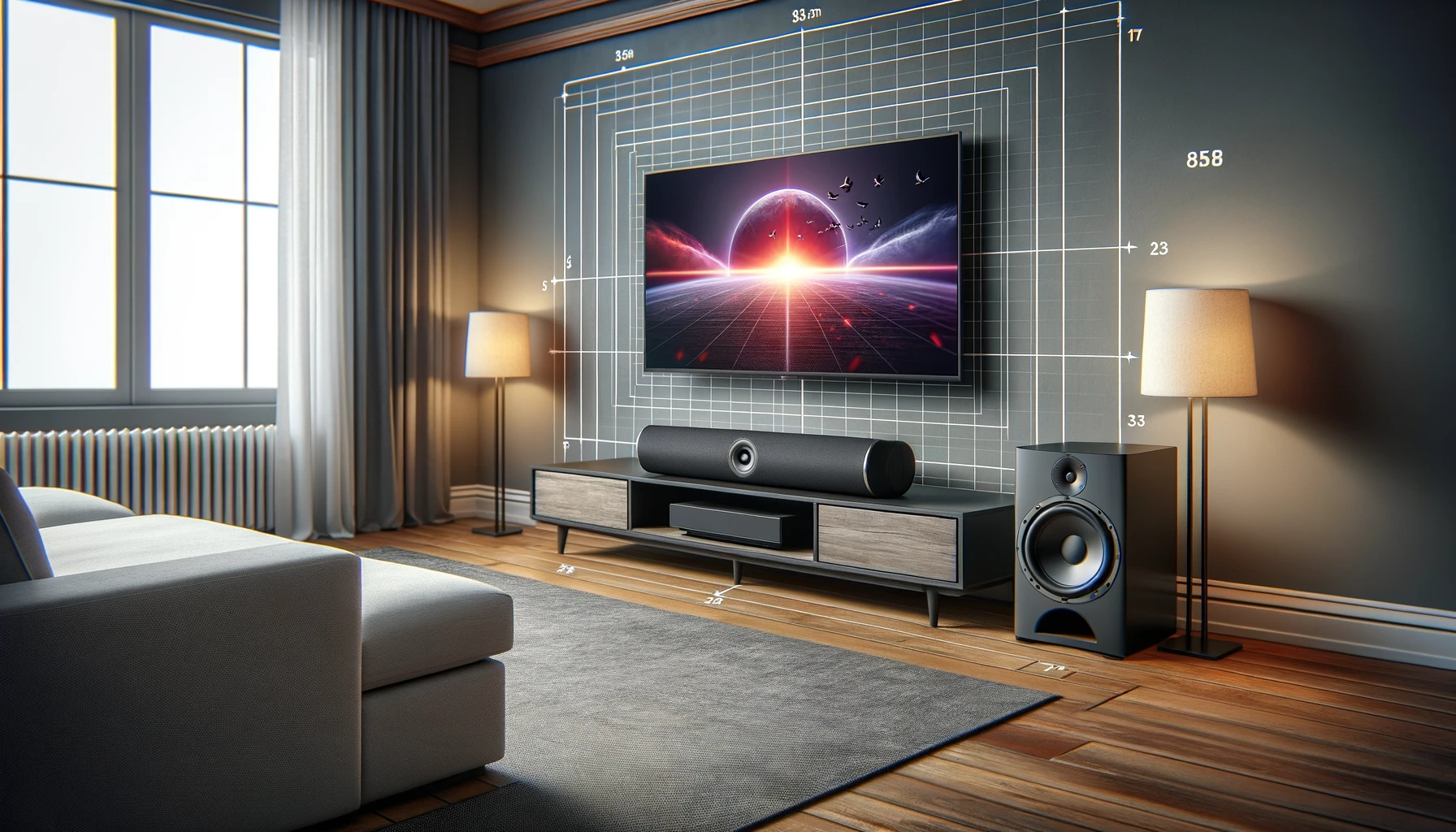Where should you place a soundbar and subwoofer for the best audio experience?
With strategic positioning guided by room dynamics, you can achieve full, realistic surround sound during movies, gaming and music.
Let’s explore the details behind artfully arranging an entertainment setup.
The Sweet Spot for Immersive Listening
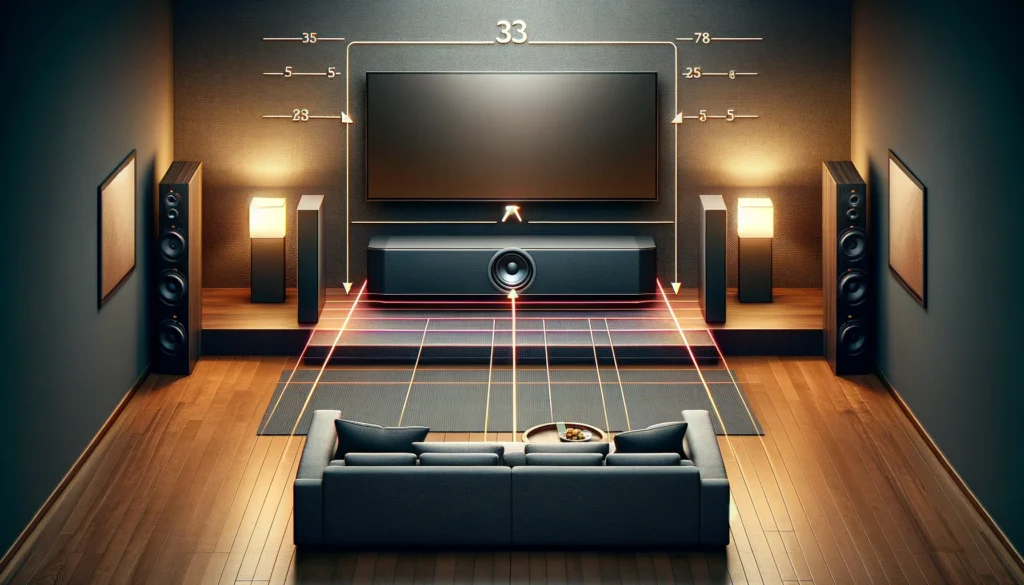
The optimal place to position a soundbar is centered below the TV, close to the screen and tilted slightly downward.
This anchors the audio to the display for a realistic effect.
Place the subwoofer along the center of the longest wall, away from corners, for an even bass response across seating spots.
We’ll explore more nuanced guidance in depth ahead.
Positioning The Soundbar

A soundbar should be placed centered below your television set, at the same level where your ears would be when seated in the main viewing position.
Typically this would involve either placing the soundbar directly on your media console if it is wide enough, or mounting it to the wall at seated ear height by using appropriate mounting hardware.
The intent behind centering the soundbar is so that the audio appears to emit from the screen area for a realistic cinema effect during movies and television viewing.
Additionally, for optimal audio quality projection it helps to angle your soundbar at a slight downward tilt aiming it towards your primary listening area.
This focuses the soundwaves being emitted for a better encompassing listening experience in your entertainment seating.
As soundbars are designed to enhance the sound performance of modern slim display panels which lack sufficient built-in speakers of their own, placing the soundbar as close to the screen as possible maintains the illusion.
Allow for open space in front of the soundbar when positioning it by not placing objects directly in front which can impact sound wave projection.
Enclosing soundbars tightly inside cabinets should also be avoided as this can negatively affect audio performance.
The sound waves require sufficient area to resonate outwards from the speakers within the unit, so leaving adequate room in front allows for this to occur properly.
Placing The Subwoofer
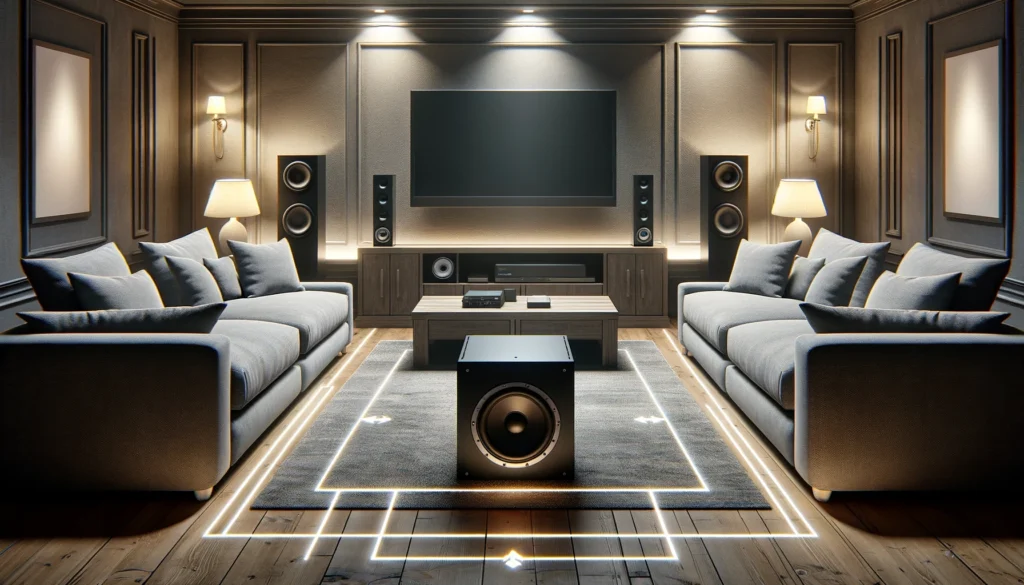
Determining optimal subwoofer placement requires paying attention to a few key guidelines which can make a noticeable improvement in your listening experience.
Your entertainment system’s LFE (low frequency extension) channel contains mainly bass effects, so the subwoofer is a dedicated speaker for handling the bass frequencies being produced during movies, gaming and music playback.
One of the most popular recommendations is to place your subwoofer along the same plane as your main front speakers or soundbar, in either the front right or left corner of the room.
Bass frequencies are amplified when striking two perpendicular surfaces which intersect, so corner placement utilizes this acoustic phenomenon to your advantage resulting in louder and richer bass performance.
Using this approach does limit bass consistency across multiple seating positions however.
For maintaining a more balanced low frequency response throughout your entire listening area, subwoofer positioning along the center of the longest wall in your room can be better solution.
Mid wall placement radiates bass evenly across a wider sweet spot, reaching multiple seating positions.
Floor coupling is also important, so having the subwoofer make contact directly on your flooring surface allows the vibrations to better transfer increasing tactile feedback.
Using isolation pads beneath the subwoofer can help prevent unwanted rumbling noises being transferred into the floor in this case.
Sometimes bass can become too accentuated when placing a subwoofer near room boundaries which causes “boomy” muddy results.
If you find the low frequencies too exaggerated when listening to your system, experiment by pulling your subwoofer slightly away from walls and corner areas which should tighten up the bass.
But allowing too much space behind or around the subwoofer can also decrease output, so finding the right balance for your room takes trial and error testing.
Considering Room Acoustics
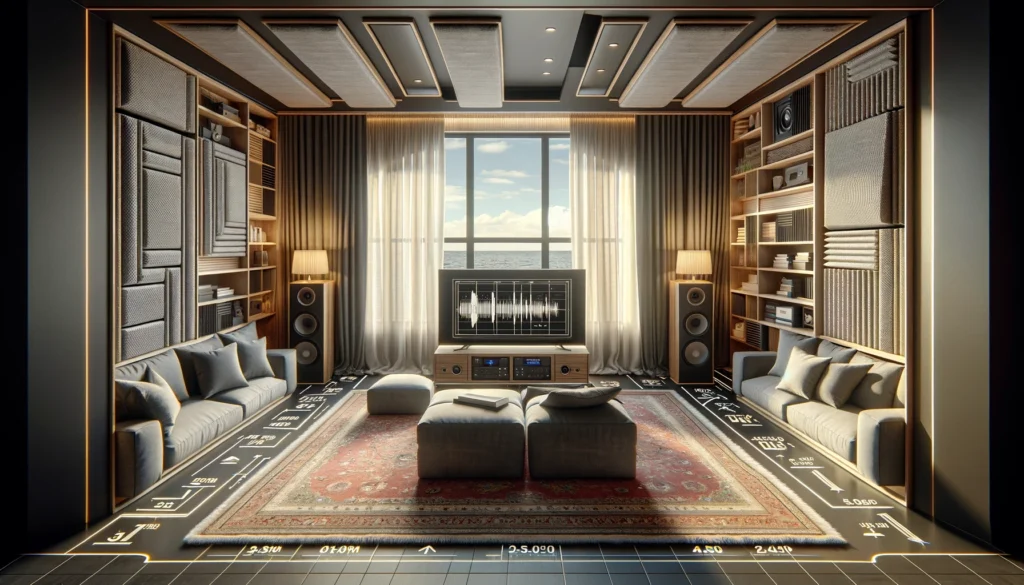
The size, shape and construction materials used in your listening room will determine other acoustic considerations beyond just speaker placement alone when setting up an entertainment system.
Sound waves can reflect off hard surfaces causing unwanted echoes which disturb audio clarity.
Bare wall exposures, large glass windows and vaulted ceilings are examples of elements which can over-liven a space resulting in distracted listening and dialogue intelligibility issues.
Using sound dampening materials helps absorb some of these excessive reflections to better control resonation issues in the room’s acoustical environment.
Hanging thick drapes over large windows, laying down area rugs on hard floors, or installing soft furnishings helps mitigate unwanted sound reverberation problems that empty rooms often exhibit by default.
Diffusing solid surfaces also assists by scattering sound waves in multiple directions instead of directly bouncing them back towards the listening position.
Acoustic wall panels or bookcases serve this diffusive purpose well and further aid sound absorption in the space.
Additionally, the positioning of heating and cooling vents or open exterior windows in relation to your speaker setup should be analyzed, as air currents can negatively interact with sound wave propagation causing unwanted modulation effects.
Avoid locating equipment directly within the path of HVAC airflow routes when possible.
Duct baffling, fan speed adjustments or vent repositioning may be required in troublesome cases to reduce audible ventilation noise interference.
Sealing outside facing windows can also help minimize unwanted soundwave dissipation decreasing system output.
Connecting Surround Sound Speakers

For full cinema immersion, complementing your main front sound system with rear surround speakers and a subwoofer greatly enhances the experiential impact of your entertainment setup.
Surround speaker placement guidelines facilitate an enveloping audio field surrounding the listener for added dimensionality and spatial presence when enjoying multi-channel content.
Side surround speakers should be positioned evenly spaced from the central seating area at approximately 90 to 110 degrees left and right.
Some elevation using stands allows the surround speakers’ output to emanate towards the listeners’ ear level avoiding sound absorption from furniture below.
Angling surround speakers inward also focuses their projection on the central sweet spot where viewers are seated.
Rear speakers capable of delivering the surround channel audio information help complete the 360 degree soundstage development encapsulating the room.
Mounting rear speakers positioned directly behind the central seating row facilitates the full encompassing surround sound effect.
Some upward angle towards the listening position assists clarity but is not entirely necessary as rear speakers mainly deliver more diffuse ambient effects.
Following proper surround sound wiring guidelines maintains appropriate channel assignments and polarity for seamless panning between speakers.
General rule of thumb is maintaining equidistant sides with each speaker positioned at equal distances from the central seating point.
This creates a balanced soundstage so audio effects exhibit uniform intensity as they pan from channel to channel.
However asymmetrical room dimensions often require some flexibility on exact placements to find locations allowing for ideal angling towards the listening position.
Testing alternate configurations aids decisions when unable to adhere to all guidelines optimally.
Testing Positions With Audio Content
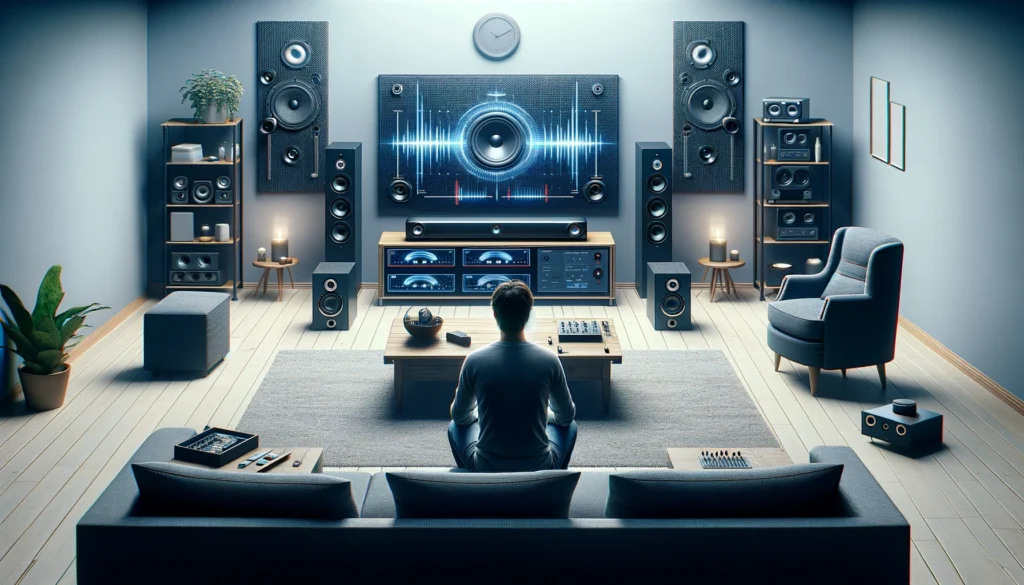
Finalizing appropriate placements for your sound system equipment requires spending time critically listening to content from multiple seating positions while making adjustments.
The interaction between speakers and a room’s unique acoustic profile means theoretical perfect positions may not always yield ideal real world results inside your space.
Only through sound testing can deficiencies be tuned.
Playing dynamic movie or music content containing heavy bass allows you to audibly identify problematic room modes exhibitng boomy resonating tones when bass notes strike them.Tracks with sustained low frequency rhythms simplify noticing these issues.
Listening for balanced response across multiple seating zones ensures your subwoofer location integrates evenly throughout the space.
Occasional amplifier releveling may help smooth disproportionate hot spots acoustically favoring certain room locations.
Walking slowly around your listening environment during audio playback reveals dead zones which audio mysteriously disappears or dulls whenever passing through.
Making note where these voids occur helps steer equipment repositioning or acoustic treatment additions eliminating the dead space.
Panoramic sound panning tests also highlight poor surround channel seamlessness when audio effects seem to jump between speakers or exhibit voids rather than smoothly transitioning the sound waves within the stage.
Repeating content sampling across a wide sample of movies, music and television source material while making iterative positional adjustments will get your setup fine tuned for your room.
When balanced, consistent and enveloping surround sound is achieved with solid imaging throughout your seating, you have effectively optimized placement maximizing your entertainment gear’s performance capability.
Enjoy precision tuned audio amplifying your viewing experience.
Conclusion
After considering the many factors of soundbar and subwoofer positioning, room acoustics, wiring, and content testing, the optimal sound system arrangement results in clear and balanced audio with resonant bass filling the space for ultimate entertainment immersion.
Following the placement and testing guidance outlined here will help achieve surround sound nirvana tailored to your listening desires.
